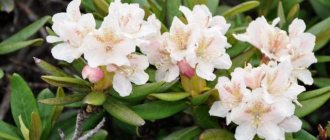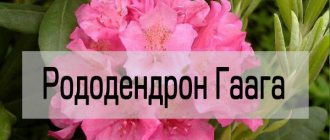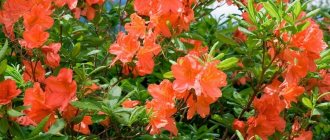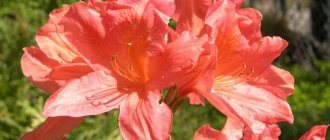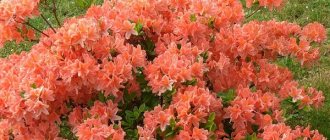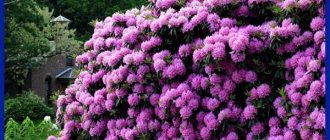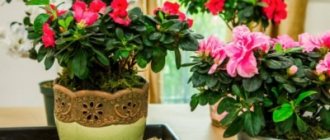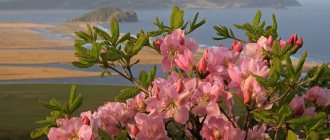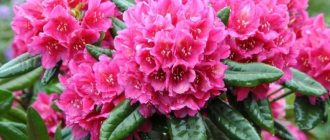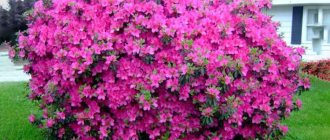Articles / Plants /
Rhododendrons are rightly considered difficult to grow in agricultural technology. Your humble servant knows this firsthand. If you treat a rhododendron according to the rule - “plant it and forget it”, that is, take it like a little boy into the forest and leave it to be devoured by the wolves, then nothing good will happen to it. There are no indestructible rhododendrons - this is a fact. But the same fact is that in natural conditions not a single tree has a guarantee of survival.
However, among rhododendrons there are their “iron men” (steel men), with outstanding adaptability. One of them is yellow rhododendron. My story about it is based on the experience of growing it in our country garden and its surroundings.
Planting and care of yellow rhododendron (Pontic azalea)
Landing
As noted above, Pontic azalea prefers thin, gravelly soils with a slightly acidic or neutral reaction and moderate moisture.
For planting, it is better to choose well-lit or slightly shaded places, protected from the wind (especially from the north). In general, the technology for planting and caring for yellow rhododendron is similar to planting and caring for Daurian rhododendron. An important feature: when planting, do not bury the root collar, but rather place it a couple of centimeters above ground level, since the soil in the hole will still settle. Care consists of mulching, weeding, watering and occasional fertilizing. Everything is the same as for Daurian rhododendron (see above).
Reproduction
Propagation by seeds, green cuttings and dividing the bush.
Pontine azalea seeds are sown in early March in boxes or bowls. Planting depth is no more than 1 cm. After sowing and watering, the boxes are covered with glass or film until the seedlings appear.
The first shoots appear after 10...15 days, mass shoots - after 3 weeks. After the appearance of a developed pair of cotyledon leaves, the seedlings are carefully planted at a distance of 1.5...2 cm. The second planting with a dive is carried out after the appearance of two pairs of true leaves.
Water the seedlings through a tray, always draining excess water after the lump is completely soaked.
Seedlings with 6...10 developed true leaves are transplanted into separate pots with a diameter of about 5 cm. The optimal composition of the soil mixture is peat: coniferous litter: turf soil in a ratio of 2:1:1. Azalea seedlings die in clay soil. It should be replanted with a clod of earth so as not to damage the rather weak root system.
By the end of the first year of life, yellow rhododendron plants are only a few centimeters tall, but often form branches.
The second transplant is carried out at the beginning of the second year of life - in pots with a diameter of up to 10 cm. After transplantation, the plants are fed. To do this, you can use a complex fertilizer for house plants. In summer, two-year-old seedlings can be taken out into the open air, choosing places protected from wind and direct sunlight. During the year, fertilizing with complex fertilizer is carried out every 3...4 months.
Starting from the third year, seedlings require a minimum of care - only watering and regular feeding. In the 4th...5th year, the plants can be planted in the nursery, caring for them as before.
Plants grown from seeds bloom at 4, sometimes at 5 years of age. It is better to remove the flowers formed during the first flowering immediately so that the rhododendron can get stronger.
Propagation by green cuttings
In general, the technology is very similar to the propagation technology of Daurian rhododendron. The difference is that even when treated with 0.005% indolylbutyric acid, no more than 20% of the cuttings of yellow rhododendron successfully root. This makes it difficult to obtain a large number of bushes, but plants obtained from green cuttings often bloom the next year.
Reproduction by dividing the bush
Pontine azalea reproduces well by dividing the bush, but it is difficult to obtain a large number of plants in this way.
Agricultural technology.
Rhododendron yellow is naturally highly adaptable. In the foothills of the Caucasus, it usually settles on poor dry soils, along forest edges and clearings. In Turkey, it can be found on rocky mountain slopes at altitudes of 500-2500 meters. In the Carpathians and Alps, it grows in mixed mountain forests, not only along the edges, but also under a sparse canopy.
Landing place. The soil. Yellow rhododendron is sun-loving and relatively drought-resistant. Even in the south, where insolation is relatively high, it usually prefers open locations. As for central Russia, here the bush is shown open sun. It can grow in the shade, but this reduces the vitality of the plant. The proximity of groundwater is also undesirable, and spring flooding with melt water is unacceptable.
The soil is sandy loam or light loamy, with a slightly acidic or neutral reaction pH = 5.0-6.5. The soil mixture can be made up of turf soil, peat and sand in a ratio of 1:2:1.
Other options:
Heather soil, peat, sand 2:1:1.
Leaf soil, peat, sand 1:2:1.
Considering the shrub’s ability to spread widely, the planting site is formed shallow, but wide enough: depth 25-30cm, diameter 2-2.5m.
How to distinguish an azalea from a rhododendron by appearance
The main difference between representatives of the same genus from each other can be described in two words - dwarfs and giants. An azalea bush never exceeds 50 cm in size, most often its height is 30 cm. At the same time, the diameter of the inflorescences reaches 7-12 cm. Such compact plants grow well in standard flower pots. They can be placed on the windowsill in a row with your usual house plants.
An indoor flower will not take up much space
The height of wild rhododendron and its garden varieties can reach 3 m, in rare cases - 4 m. Powerful bushes or small trees are planted as hedges or as large tapeworms on the lawn.
Important! Among frost-resistant rhododendrons there are also compact-sized species. It is wrong to consider all small shrubs as azaleas.
Other differences in appearance:
- different number of stamens in the bud;
- the shape of an azalea flower resembles an open funnel, while that of a rhododendron has a bell-shaped bud;
- the foliage of miniature specimens is covered with barely noticeable fluff, the leaves of large plants are scaly;
- almost all azaleas (except Japanese) lose their foliage during the dormant period; evergreens are found among rhododendrons.
History[edit | edit code]
The ancient Greek writer and military leader Xenophon talks in his work “Anabasis of Cyrus” about a strange disease that engulfed his army in the territory of what is now Kurdistan. Local residents knew that they needed to beware of “crazy honey,” but the army, hungry for sweets, who came from distant Greece, almost suffered death. The honey collected by the warriors was made from the poisonous nectar of the yellow rhododendron, used by bees living in the region. After some time, the people of his army recovered.”[7].
Problems during cultivation
Rhododendrons are quite resistant plants in the external environment, especially bushes of the yellow variety, but they can also get sick. Here are some problems that gardeners face:
- Rhododendron does not bloom. This may be due to insufficient or excessive soil acidity, lack of nutrition, as well as overheating of the roots. It should be remembered that the root system of the shrub should be in the shade, and the crown in the sun.
- Chlorosis. A disease that occurs due to improper care, all varieties are susceptible to it. The leaves of the plant begin to turn yellow at the tips, then turn rusty or brown. The problem occurs when the soil is insufficiently acidic, the bush is fed with ash, or the clay content in the planting mixture is too high. As a result, iron and manganese are poorly absorbed. It is necessary to acidify the soil and apply fertilizer based on iron chelate or ferrovit.
- Rhododendron cicada. The insect itself does not harm the plant, but it carries a fungus that affects the buds and buds. The cicada lands on the rhododendron in late August to lay its eggs. Along with the eggs, she brings a fungus that settles in the kidneys and survives the winter. In spring you can see flower buds and leaf buds that turn black, do not develop and, at the same time, remain on the branches. To prevent the disease, you need to destroy cicadas with insecticides, spray the plant with copper sulfate or treat it with fungicides. Affected buds and buds are removed.
- Late blight. The disease begins with the leaves wilting, then they turn yellow along with the branch. The roots begin to rot, and the root collar turns black. You can fight late blight with antifungal drugs and copper sulfate. If the plant is severely affected, it is better to dig it up and burn it.
- Pests. Among the pests, rhododendron is most often attacked by weevils, mites, mealybugs, and thrips. These insects can be controlled using insecticides or physically removing pests from branches with soap solutions. The bushes also suffer in the spring from snails and slugs, which are easiest to collect from the leaves by hand.
Rhododendron Yakushimansky - planting and care
This plant has good winter hardiness, so it is recommended for cultivation in the central zone of our country.
It is important to remember the maintenance rules, because improper care can destroy the shrub. Landing
Landing
The best time to plant Yakushiman rhododendron is the end of April, when the soil is completely warmed by the sun. You can also plant in the fall, at the beginning of September, when there are no frosts yet.
Azalea does not tolerate direct sunlight. An open place exposed to winds will also be a dangerous place for it. The best location is partial shade.
When planting, do not deepen the neck of the root, otherwise the seedling may rot. It is necessary to ensure that the root system is 3-4 cm above the soil.
You can plant rhododendron as a separate bush, or you can create a group composition. Such evergreen shrubs will decorate the garden.
Priming
Azaleas prefer loose, acidic, humus-rich soil. You can prepare the soil yourself. To do this, you need to take two parts of peat soil, two parts of coniferous soil and one part of river sand. When planting, it is advisable to place drainage (expanded clay, pebbles, sand) at the bottom of the hole to avoid stagnation of water.
Watering
Rhododendron Yakumashinsky is moisture-loving, so it is important to monitor the amount of watering. Watering is done 2-3 times a week; in dry weather, spraying is recommended
Temperature
Frost resistance is a characteristic feature of this plant. It can withstand cold temperatures down to -30 C. But it should be remembered that young seedlings need to be covered for the winter.
Fertilizer and feeding
For proper growth, rhododendron should be fertilized 3 times per season. The first time - before flowering (20 grams of fertilizer for feeding azaleas per liter of water), the second time - immediately after it (with the same fertilizer), the third time - at the end of August (25 grams of superphosphate and 15 grams of potassium sulfate). The third feeding is necessary to ripen the bark and prevent the formation of young shoots.
Bloom
The flowering of Rhododendron Yakushimanensis is unusually beautiful and abundant. Flowers collected in inflorescences sprinkle the entire bush. It begins at the end of May and continues until the end of June.
Trimming
This plant does not require special pruning
But there are situations when it is important to do this, for example, removing dead wood and dead branches
After flowering, it is recommended to cut off spent blooms for a variety of flowers next year.
Transfer
Transplanting azaleas is often painless at any age, but you should remember that you should not disturb the earthen ball so as not to damage the root system. The best time to transplant is spring and autumn.
Reproduction methods
There are several ways to choose which one to choose - each gardener decides for himself.
Seeds. Seeds are planted in January-February. Sowing occurs superficially in nutritious soil. Shoots appear within a week.
Seedlings are planted in a permanent place of growth only after a year.
By cuttings. To obtain cuttings, you need to cut a branch 5 cm in size and having 3-4 internodes. The cuttings are placed in peat-sand soil. Within a month, rooting occurs and shoots and leaves appear.
By layering. For this method of propagation, in the spring, select the lower branch, cut it slightly and immerse it under the soil.
It is important to water the cuttings and sprinkle them with nutritious soil. By mid-July, the cuttings will take root and can be cut off from the mother bush and transplanted to another place
By division. An adult bush is dug out of the ground and divided into parts. Each part is planted separately. After 2-3 years, the bush will completely recover and acquire its decorative properties.
Wintering
Yakushiman rhododendron tolerates low temperatures well, so it does not require shelter for the winter.
But young shoots must be covered in the first few years after planting.
To protect young bushes from frost, you should cover them with spruce branches, and as the temperature drops, sprinkle dry leaves on top.
Caring for adult plants in the fall is as follows:
1. The last watering should be done before the first severe frost to prevent dehydration of the root system.
2. In autumn, mulch (peat, pine needles, dry leaves) should be poured in a layer of 10-15 cm near the bush to protect small roots from the cold.
Reproduction
Hybrid yellow rhododendron is propagated vegetatively. This way the varietal characteristics of the shrub are preserved. In summer, cuttings are cut and rooted in a substrate of peat and sand. The process takes up to 1.5 months. To improve rooting, the cuttings are kept in a solution of a growth stimulator. They are planted in a permanent place after 1 - 2 years.
Yellow rhododendron is also propagated using root shoots. It is separated from the mother bush and planted in a new place. In addition, they practice growing the crop from seeds. They are distributed over the soil surface without stratification. The seedlings are kept in greenhouse conditions.
Varieties of Japanese rhododendron
The classic orange Japanese rhododendron will brighten up any area, but the plant looks even more beautiful when surrounded by other shades. The following varieties are most popular among gardeners in central Russia.
Japanese salmon rhododendron
The hallmark of this variety is not only the bright shade of lush and large inflorescences. The winter hardiness of Japanese salmon rhododendron is its valuable quality, which made it possible to grow it not only in the middle zone, but also in the front gardens of the Moscow region. It is easy to recognize the variety by key features:
- height – up to 2 m;
- flowers are salmon-colored, up to 7 cm in diameter, collected in inflorescences of 6-12 pieces;
- flowering duration - 3 weeks from mid or late May;
- elongated green foliage 10-12 cm long acquires a fiery hue by September;
- gray bark.
For planting, seedlings aged 2-4 years are purchased. The unpretentious Japanese salmon rhododendron is planted where there is not sun all day, otherwise the delicate flowers will easily burn. Places near fences are good. The variety is very moisture-loving, but requires fertilizing once every 2-3 years.
Rhododendron japonica cream
The creamy shade of the petals in this group of varieties is often combined with a bright yellow flower core and equally large stamens. A pleasant delicate aroma is characteristic of all Japanese rhododendrons. Its peculiarity is that it does not tolerate proximity to large trees, but it thrives on lawns surrounded by grass and on slopes. It is advantageous to plant in areas with large differences in elevation, so it is often used to create terraced landscape compositions.
Depending on the variety, the height of the bush reaches 1.2-2 m, and grows in one place with proper care for up to 40 years. The leaves grow up to 4-10 cm in length, and the flowers are collected in inflorescences of 6-12 pieces. The corollas are so lush that the foliage behind them is almost invisible. By autumn, the foliage on the bushes turns yellow-purple instead of dark green.
Rhododendron japonica Babushka
Belongs to the dwarf varieties. The compact bush grows only 50 cm in height and width. The semi-double carmine-pink flowers are very lush. Only the red Japanese rhododendron looks brighter. The shiny dark green foliage turns yellow in autumn. The variety is semi-evergreen.
It is recommended to plant in semi-dark areas. Belongs to winter hardiness zone 6. Loves abundant watering and mulching. Bushes require pruning once a year - late autumn or early spring before buds open.
Rhododendron japonica Schneeperle
Azalea rhododendron japonica Schneeperle is one of the earliest varieties. Flowering begins in mid-April and lasts until the end of spring. Pale white flowers look great in holiday bouquets, such as wedding bouquets. The corollas of the flowers are relatively small - 4-5 cm in diameter, but very lush, reminiscent of tiny roses.
The bush is unpretentious, but grows very slowly. A 10-year-old plant has a height of only 35 cm and a width of 55 cm. The main application is the formation of borders in multi-row decorative plantings. The peculiarity of the variety is that it requires formative pruning after flowering in June. This gives the plant an incentive to form flower buds for the next season. Withstands frosts down to – 29 °C. The root system is shallow, prone to growing in breadth. It is highly not recommended to bury the root collar, as this can lead to the death of the bush.
Rhododendron japonica Snow White Prince
This variety can also be found on sale under the name White Prince. The flowers are either completely snow-white or with a soft pink center. It looks especially impressive next to the orange Japanese rhododendron/azalea. The bush is tall - up to 2 m in height. The flowers are medium-sized - 6-8 cm in diameter. The leaves are elongated, green in color, up to 10 cm long. Winter hardiness is average; in regions with frosty winters, covered agricultural technology is recommended. Planting material – 3-year-old seedlings. Younger seedlings obtained from seeds are grown in greenhouse conditions. For planting in open ground, choose a shaded place, well protected from strong winds and direct sunlight.
Bloom
When and how does this happen?
Flowering occurs in winter and spring and can last from one to two months. The flowers are collected in spectacular inflorescences of 12 pieces. During flowering, the bush is almost completely covered with flowers; no leaves are visible.
Care before and after
The most important thing is to create conditions that promote, and not hinder, the development of the plant. Before flowering, Azalea Pontica needs moist air, moderately moist soil, and good lighting. After flowering, the bush needs pruning and shaping.
Attention! Monitor watering; the soil should not dry out.
What to do if it doesn't bloom?
Maybe you shaded the plant too much and it needs light. It is worth rearranging it closer to the light or providing additional illumination with a phytolamp. Another reason may be dry air - be sure to humidify the air.
Diseases, pests and problems of growing Pontine azalea
Through soil, tools and from other diseased plants, rhododendron can become infected with fungal diseases:
- If, starting from the top, the leaves begin to wither, become brown and fall off, and a pink coating has formed on the root collar, then the plant has become ill with fusarium. The bush needs to be isolated and treated with Fundazol solution.
- Various red-brown spots on the leaf blades are a sign of Alternaria blight. Bordeaux mixture should be used.
- The appearance on the leaves of brown spots with a darkish border, and then their middle drying out and rash occurs with phyllocystic disease. The affected areas must be removed and sprayed alternately with drugs such as Topsin-M and Fundazol.
- Cercospora blight can be recognized by brown spots with a reddish border on the underside of the leaves, and the upper part is covered with a gray coating. It is recommended to use Fundazol, Ditan M-45.
- The leaves change color, curl and dry out, and the buds die off - the cause may be root rot - late blight. At an early stage, treatment with copper oxychloride or Bordeaux mixture will help.
Often, problems with azaleas arise due to poor quality planting and maintenance:
- Leaves wrinkle - this is a signal of low light levels, moisture deficiency, and temperature violations. By the way, a sharp decrease in temperature can cause necrosis (the leaves turn brown, the main vein dies). A cold draft can trigger such a disaster. The leaves do not regenerate and must be removed.
- Yellowed leaves and a dull appearance indicate a lack of oxygen, minerals or poor soil composition.
- Lack of fertilizing or too frequent and intense watering are the causes of mixed chlorosis (the edges of the leaves become covered with yellow spots). Foliar feeding is required, which includes iron and magnesium.
Often the causative agents of diseases are pests:
The presence of spider mites is indicated by a thin web on the underside of the leaves. They suffer from a lack of juice, become gray-brown and soon fall off. At the initial stage, washing with soapy water should help. Recommended drugs are Actellik and Agravertin. The strawberry mite feasts on buds, shoot tips and flowers. The edges of the leaves curl, and instead of large buds, many small ones are formed. Actellik should be used against it (3-4 times with an interval of 9-10 days). If the pest is accustomed to this product, you can use Neoron. In the fight against the red tick, the same methods are suitable as against its fellows.
It is important to note that mites are carried on clothing, so it is not just the plant that needs to be treated. Carry out processing in special clothing and a respirator.
Another destroyer of azaleas is the greenhouse whitefly.
As a result of its activity (it sucks out the juice), the leaves become discolored, wither and fall off. A sooty fungus appears on her secretions. It is an active carrier of many diseases. It is necessary to wash the plant with a sponge and soapy water and treat it with Actellik or Aktara, Karbofos. Greenhouse aphids also carry all sorts of diseases. She makes invasions in colonies. Leaves curl, growth and flowering slow down. You need to use Karbofos, Actellik or Ambush against it. Adults and mealybug larvae quickly destroy the plant, penetrating into the leaf axils and flower scales. If the pest has not had time to manifest itself strongly, you can wash it with warm water and wipe it with a soapy sponge. In a more complex case, you will need Actellik.
The azalea moth prefers to feed on the parenchyma of leaves, which then crumble and fall off. The pest's caterpillars roll the leaves into a tube. It is necessary to get rid of moths by spraying with sulfur or fumigation. A lover of dry environments, the greenhouse thrips pierces a leaf with its proboscis and sucks out the juice. The leaves become whitish, with brownish-brown spots. A good result can be observed after washing with water and laundry soap. Infusions of tobacco and yarrow are used, as well as Actellik, Decis, Aktaru. The grooved weevil (also known as the grooved weevil) feeds on buds, flowers and buds, and its larvae gnaw off the root collar and destroy the roots. First of all, you need to replant the plant. The larvae should not get into the new substrate. In the fight against mowing, Karbofos, Bazudin, Diazinon or Furadan are used.
Pollination with chemicals is best done at night, when adults are most active. You can water during the day.
It will also be interesting: White Phalaenopsis orchid - home care and growing a flower?
Conditions for growing yellow rhododendron
Yellow rhododendron is suitable for growing in the middle zone, the North-West, the Urals, Western Siberia, and the Far East. The shrub tolerates winters well under cover. For planting, choose frost-resistant varieties that can withstand even difficult climates.
Ideal conditions for growing yellow rhododendron:
- sunny place or partial shade;
- regular supply of moisture to the soil;
- high soil fertility;
- air humidity;
- shelter for the winter.
Deciduous yellow rhododendron is used in single and group plantings. The plant becomes the central part of the composition. It looks especially impressive next to other deciduous rhododendrons, against the backdrop of lawns and evergreen trees.
The culture is sensitive to lack of moisture. Therefore, during the growing season, watering must be organized, while avoiding stagnation of water. The duration of flowering is affected by the fertility of the soil. Before planting, the soil composition is improved by adding humus and peat.
How is this plant used in life?
Rhododendron tolerates weather changes and dry periods well, so it is advisable to plant it on the streets and in city yards.
Note ! The shrub is not afraid of air pollution, so it is often planted on medians and at highway junctions.
Pontine azalea looks good alone and in groups of several pieces, resulting in uniform thickets. This composition will look good in the middle of the lawn or next to a group of trees.
The yellow color goes well with any other color, so it can be safely planted with other types of azaleas that are available for growing in the region. It is popular to plant shrubs next to conifers, such as thuja or juniper.
Conditions for growing yellow rhododendron
For rapid growth and flowering of rhododendron, it is enough to choose the right place for planting. This is a light-loving plant that tolerates partial shade well, but not the complete absence of sun.
Gorgeous azalea inflorescences
If spring and summer are not dry, and the amount of precipitation is normal, the plant does not require additional watering. If there is no rain, it is recommended to water the azalea once a week. however, this should be done in the evening.
The bush can be fed twice a month. This is done when the plant begins to bloom, that is, from April to June. Mineral and nitrogen fertilizers alternate.
Note! Other types of azaleas require the elimination of nitrogen fertilizers towards the end of flowering; this does not apply to the Pontian species. The following raw materials are used as natural fertilizer:
The following raw materials are used as natural fertilizer:
- crushed conifer bark and sawdust;
- pine litter;
- high peat;
- heather soil (soil from coniferous forests where many heathers grow).
The easiest way to apply such fertilizers is by mulching.
Just so you know.
Heather land. The top (from 5 to 15 cm thick) layer of soil, from a mixed, or better yet, pine forest, at the foot of which any of the heathers grow: lingonberries, heather, wild rosemary, blueberries, etc. Includes litter (coniferous litter, rotted branches, decomposed wood, leaves) along with part of the bedrock. For rhododendrons, the greatest value is heather soil from old pine forests, which has a sandy loam base. Heather soil is permeated with hyphae of symbiotic fungi useful to all heathers.
High peat. A product of the last stage of swamp overgrowth, when sphagnum mosses dominate and trees take over. It has a red color and a fibrous structure. Has high moisture capacity. Has high or very high acidity pH = 3.5-4.5.
Coniferous litter. At the foot of centuries-old pines, in old pine forests, a layer of fallen needles accumulates in varying degrees of decomposition. Sometimes its thickness exceeds 5cm. Coniferous litter is raked with a rake, lightly grabbing the root soil. It is a valuable component for making soil mixtures and the best mulch.
In addition to pine, spruce and larch can be suppliers of coniferous litter in central Russia. And in other regions there are also fir, hemlock, and false hemlock.
Leaf soil. Soil substrate, the basis of which is rotten leaves of forest species: birch, aspen, hazel, linden, maple, oak, alder, etc. Leaf soil, usually prepared in the garden. To do this, they rake the leaves with a rake, lightly grabbing the soil itself, put them in piles, and leave them to rot. In fact, after a year this mass is “ready for use.” But it’s better to wait two years, when it becomes completely homogeneous.
When composting, leaves can be additionally layered with soil. Depending on the mechanical composition of the “interlayer”, the sheet soil will look different and its use may be different. When interlayered with loam, the result is something like very rich black soil. And when interlayered with sandy soil - a loose fertile substrate is a valuable material for preparing the soil mixture and mulching.
Heather compost. Heather compost is a universal fertilizer for all heathers that you can make in your garden. Let me remind you that in addition to rhododendrons, heathers include such garden crops as blueberries, cranberries, lingonberries, redberries, Erica, heather, andromeda (podbel), kalmia, leukotoe, wintergreen...
The components of heather compost can be all the components that have already been mentioned, that is, heather soil, peat, pine litter, leaf soil. In addition, sawdust and bark of pine and spruce, sphagnum moss, half-rotten trunks and branches of forest trees, and rotten stumps can be used to prepare compost. It is advisable to put all of the above in a dense pile somewhere on the periphery of the site. But not in the sun, and not on a hill, but in some lowland, where it is constantly humid. As a rule, compost is ready no earlier than 3-4 years from the date of laying. The criterion for readiness is complete rotting of the bark and small branches.
Heather compost can be used as a universal material - both for creating a soil mixture and for mulching.
Fertilizer. Watering. Despite its well-known unpretentiousness, yellow is responsive to fertilizer. But his fertilizer has a pronounced “heather” specificity. Only organic matter of natural origin is used as fertilizer: high-moor peat, heather soil, pine litter, sawdust and crushed bark of conifers (pine, spruce, fir, larch). If possible, it makes sense to specially prepare “heather compost” (see above). It is advisable to harvest heather soil for yellow rhododendron in old pine forests growing on sandy and sandy loam soils.
Since the soil under rhododendrons is not dug up, the method of applying fertilizers is also unusual. It is shown to fertilize them using the mulching method. It is recommended to apply mulch in small doses throughout the entire gardening season, from the moment the snow melts in the spring until work in the garden is completed. If possible, this can be done in winter. In this way, the processes of leaf fall and branch fall that occur in nature are imitated. The area where fertilizer is applied should be slightly larger than the projection of the roots. For an adult bush, this is a circle with a diameter of 2-2.5 m.
Mulching has another beneficial side. The mulch gradually rots and turns into a homogeneous organic mass that has the ability to absorb moisture and prevent its evaporation by the soil. In rain, mulch accumulates moisture, in drought it releases it, and thus smoothes out fluctuations in humidity in the soil and in the air.
Watering rhododendrons, by the way, also has its own characteristics. For irrigation, use water from natural bodies of water (ponds, streams, rivers) or rainwater. Well and artesian water often has an alkaline reaction, therefore it is harmful for all heathers. Some types of rhododendrons simply cannot tolerate such water. And for the few tolerant species, it is undesirable.
It is advisable to water by sprinkling. In order to save water, it is best to carry it out in the evening (or even at night) hours, when evaporation is minimal. If possible, it is good to automate the watering of rhododendrons, so that the pump is turned on using a relay from 1 to 10 times a day for several minutes. Naturally, during drought it is necessary to water more often. Particularly important is the time of laying flower buds, which are responsible for the “future harvest” - the period from late June to early August.
Reproduction. Since yellow rhododendron actively grows in breadth, the easiest way to propagate it is by root shoots. When propagated by seed, seedlings usually bloom in the fifth year. The durability of the shrub exceeds 50 years.
Description
Homeland - Belarus, Ukraine, southern Russia, Poland, the Caucasus, Asia Minor. Grows in the undergrowth, on the edges, clearings, swamps, on thin gravelly soils, in the mountains at an altitude of up to 2000 m above sea level. seas. Protected in nature reserves.
Yellow rhododendron is suitable for growing in the middle zone, the North-West, Primorye, the Urals, and Western Siberia.
Let's take a closer look at the question: Yellow rhododendron, photo, description, planting, care, in garden design
Yellow deciduous rhododendron up to 3-4 m tall, branched, strongly growing shrub with oblong or oblong-elliptical leaves, up to 10 cm long, ciliated along the edge. Young leaves are softly pubescent on both sides, later glabrous. In autumn they turn yellow, orange and red. Flowers are 7-12 in corymbs, very fragrant, the corolla is yellow or orange-yellow, with a narrow cylindrical tube, expanding at the bend up to 6 cm in diameter. They bloom before or during the leaf bloom period. The fruit is a cylindrical capsule up to 2.5 cm long.
Yellow rhododendron grows relatively quickly, is frost-resistant, requires moist soil rich in humus, and does not tolerate dry air. It produces abundant root growth, grows strongly and forms impenetrable thickets. Grows well in the sun, but tolerates partial shade.
Yellow rhododendron is very decorative during flowering and in autumn, when the leaves turn bright colors. The typical form is good on the edges and in groups. Numerous garden forms - in single and group plantings in the foreground in gardens and parks. In culture since 1792
In GBS since 1952, 5 samples (63 copies) were grown from seeds obtained from St. Petersburg, Slepchan (Slovakia), GBS reproduction seeds, from seedlings from Riga and the Kintrishi Nature Reserve (Adjara). Shrub, height 1.2 m, crown diameter 130 cm. Vegetation from 18.V ± 7 to 27.IX ± 5, 131 days, rarely up to 150. Grows quite quickly, annual growth 8 (13) cm. First flowering and fruiting at 7 years old. Blooms annually, from 25.V ± 3 to 25.VI ± 3, about 30 days, sometimes 38-60. The fruits ripen at the end of October. Winter hardiness I. Seed germination 96%. 16% of cuttings take root when treated with a 1% IBA solution using the “dry” method.
Moderate. The annual growth is 15 cm in height and 15 cm in width.
Height 3 m, crown diameter 3 m.
Funnel-shaped regular, yellow or orange-yellow, 6 cm.
Elliptical or lanceolate, dark green in spring and summer, orange or red in autumn, 8 to 10 cm.
Decorative:
Yellow rhododendron is especially decorative during flowering and in the fall with the color of its leaves.
Usage:
Single plantings, decorative groups.
Botanical description[edit | edit code]
The species is very polymorphic. Some authors identify a number of varieties differing in the nature of pubescence and the shape of the leaves [5].
Yellow rhododendron is a deciduous, branched shrub 2-4 m high, growing strongly, reaching 6 m in diameter. Young shoots are glandular-hairy.
The leaves are oblong-obovate, oblong-lanceolate or oblong-elliptic, from 4 to 12 cm long, 1.5-8 cm wide, pointed, narrowed towards the base, finely serrate and ciliated along the edge, on petioles 5-7 mm long.
Flowers are on pedicels 1-2 cm long, collected in 7-12-flowered umbellate corymbs. The calyx is small, with glandular-ciliated lobes 2-5 mm long; the corolla is orange or yellow, glandular on the outside, from 3 to 5 cm long, about 5 cm in diameter, funnel-shaped, the corolla tube is narrow-cylindrical, widened at the top, the lobes are oblong. There are 5 stamens, curved, exceeding the corolla, their threads are pubescent from the base to half; glandular ovary; the style is thin, longer than the stamens.
The fruit is an oblong-cylindrical capsule 1.5-2.5 cm long.
It blooms in April - June, before the leaves appear or simultaneously with them. Fruits in June - August.
Origin
The Pontic Azalea has spread throughout the world, but more often this plant is found in Poland, Austria, southern Russia and the southern part of the Black Sea, which the Greeks called Pont Euxine.
The first mention of this shrub was by Pliny (an ancient Roman writer) and Dioscorides (an ancient Greek military leader) in 40-90 AD. They, in turn, referred to the works of Xenophon (Greek writer), dating from 430-354 BC.
Both people and bees like the aroma of these plants. But be careful, their pollen is poisonous, as is the honey produced from it.
.
The fact is that Xenophon wrote about the enmity between Cyrus the Younger and his older brother Artaxerxes II. Cyrus' army defeated Artaxerxes at the Battle of Kunaxa, but he himself was killed and his army had to retreat to the Pontic hills of the Black Sea. They wanted to collect food supplies and return to Greece. But while collecting provisions, the troops were poisoned by local honey obtained from the nectar of Azaleas growing on the Pontic slopes.
Many centuries later, the French botanist Joseph Pitton de Tournefort (1656–1708) set out to study the geography of the area. As a result of this, a description was compiled and a drawing of the Pontic Azalea was made. This tree was named Chamaebodobendron Pontica Maxima flore lutea, and this was its first name.
Yellow Rhododendron went through several names until the decision was made in the 1830s to name it by the name we still know today. In addition, the Pontic Azalea is the progenitor of many hybrids that have a wide range of shades - from soft pastel to expressively bright. For example, on the basis of this plant, Ghent Azaleas (Rhododendron Ghent) were created more than 150 years ago in Belgium.
History of origin
It appeared in culture back in 1792 - it was during this period that plant hybridization began in England. A few years later, the center of hybridization moved to Belgium and many varieties of yellow rhododendron appeared there.
Yellow rhododendron
Note ! The second name of the plant is “Azalea Pontica” or Azalea pontica L.
The word "pont" in the language of the ancient Greeks means the Black Sea, and Azalea Pontica means "Black Sea". But this name did not catch on, firstly, because the distribution area is much larger and it occupies half of Europe. Secondly, because a similar name is already occupied by another species - the Pontic rhododendron (Rhododendron ponticum), which is covered with purple flowers in the summer.
Varieties of yellow rhododendron
Many hybrids and garden forms have been developed based on yellow rhododendron. They are distinguished by decorative properties that surpass the original appearance. The plant has been known in cultivation since the end of the 18th century.
Popular varieties of yellow rhododendron:
Sante Nectarine. A hybrid up to 18 m high and up to 1.2 m wide. Its shoots are vertical and densely spaced. Inflorescences appear at the ends of the shoots. Each of them contains 6 – 12 buds. The flowers of the variety are golden yellow, with red petals on the outside. Winter hardiness of the variety – up to -25 °C;
Rhododendron yellow Sylphides. Shrub height from 1 to 3 m. The crown of the plant is round, the leaves are shiny, green
The inflorescences consist of 8 - 14 flowers, the petals of which are white-pink with a yellow spot, up to 9 cm in size; Important! The Silfides variety is one of the most frost-resistant, it can withstand cold temperatures down to -32 °C. Glowing Embers
The plant is up to 1.5 m high. Its flowers are orange in color, collected in spherical inflorescences. The first buds appear at the end of May. Their aroma is delicate and pleasant. The foliage of the crop is bright green, turning red in autumn. The shrub does not freeze when the winter temperature drops to -30 °C;
Oxidol. A shrub up to 1.2 m high. The variety has star-shaped flowers, consisting of 5 snow-white petals. They are collected in inflorescences of 6–10 pieces. There is a light yellow spot on the upper petal. The size of the flowers is up to 9 cm. The aroma is light and pleasant. In autumn the foliage turns dark red. Withstands cold temperatures down to -24 °C;
Rhododendron yellow Homebush. Dense shrub 1.5–2 m high with straight shoots. It has double carmine-pink flowers collected in spherical inflorescences. The young leaves of the plant are bronze, turning dark green in summer. In autumn the foliage turns crimson and orange. Frost resistance of the bush is up to – 25 °C.
Features of biology
Lifespan:
up to 100 (in culture up to 50) years.
Annual growth of shoots:
5...8 cm.
Lighting requirements:
photophilous.
Soil requirements:
prefers gravelly, thin soils with a neutral or slightly acidic reaction.
Winter hardiness:
high. In the conditions of Moscow and the Moscow region, it winters without shelter.
The plant is poisonous:
all parts contain rhodotoxin. Yellow rhododendron honey is also poisonous, but the concentration of poison in it is low and it does not pose a mortal danger. Symptoms of poisoning are weakness, dizziness, severe sweating, vomiting, and in severe poisoning, convulsions.
What is the difference from other types of Rhododendron
It is known that all representatives of the Rhododendron genus grow exclusively on acidic soils. The correct composition of the soil affects the flowering and viability of the plant as a whole. But this does not apply to the Pontic azalea. It is grown in almost any soil, even the poorest, which does not affect its appearance.
Note! You should not plant Pontic azalea in very dry steppe regions, such as Kalmykia, Saratov, Volgograd and Astrakhan regions. Severe winters, such as in Transbaikalia, are also beyond the reach of the bush.
Another important distinguishing feature of the plant is its ability to reproduce by root shoots, while other species reproduce by cuttings or layering.
An important feature of the species is its toxicity. The substance andromedotoxin, which is dangerous for all living beings, is found both in the above-ground parts and in the roots.
He was the first.
Rhododendron yellow (synonym Azalea pontica) was introduced into cultivation in 1792 in England. This marked the beginning of the hybridization of rhododendrons. There is no doubt that the “pontica hybrids” are the oldest group of cultivated azaleas. Subsequently, the center of hybridization moved to Belgium, where most of the “Pontic azalea” hybrids come from.
Walter Schmalscheidt, Germany.
"History of hybridization of deciduous azaleas in Western Europe."
The chronology of cultivated rhododendron is fragmentary and unreliable. Who, when and where came to the gardens of Europeans first, and who came second and third, we know only approximately. But the fact that the yellow azalea was among the first is certain. It could not be otherwise, because this species is an original European resident, and not an alien from America or Asia, like most others. And for sure, the inhabitants of the Carpathians and Caucasian foothills long ago transferred this shrub from the mountain slopes to their front gardens. But even if you count from the “first mention in the chronicles,” yellow rhododendron is still a little ahead of the others.
This rhododendron does not claim to be the brightest and most spectacular. But it has one very significant advantage over other types. In the Center of Russia, he is one of the few who can be left for another year without any care. Generally speaking, in Russia p. yellow can be grown almost everywhere where there is gardening: throughout the European part, in the Urals, in the south of Siberia and in the Far East. It feels worst in the arid steppe regions (Astrakhan, Volgograd, Saratov, Republic of Kalmykia). And you shouldn’t mess with it at all where severe winter frosts are combined with little snow (Transbaikalia). Black currant can serve as a signal crop for the possibility of growing it. Where it is able to bear fruit, it is worth trying yellow rhododendron.
